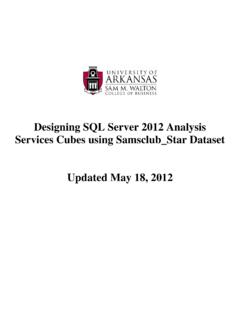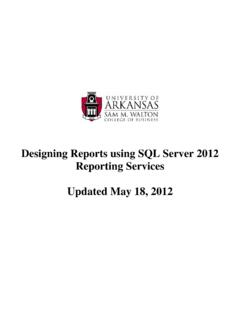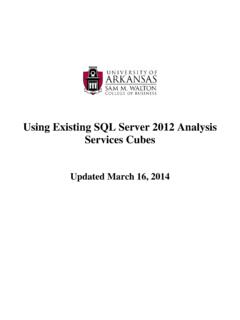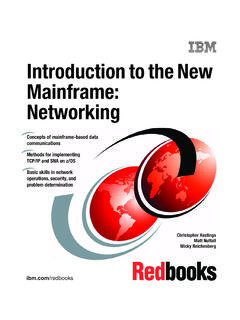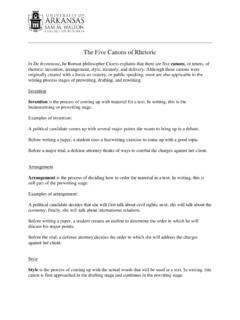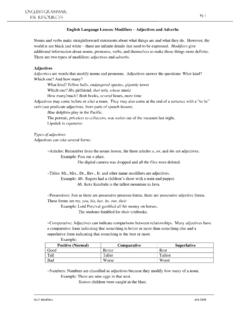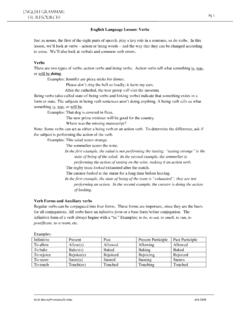Transcription of Designing SQL Server 2012 Analysis Services Cubes …
1 Designing SQL Server 2012 Analysis Services Cubes using Dillard s Dataset Updated May 18, 2012 Using Microsoft s Business Intelligence Suite to Design Cubes Once you receive your University of Arkansas MEC account, access will be via remote desktop connection. Remote access documentation is at the following link: Microsoft s Business Intelligence Suite provides tools that assist in all phases of business intelligence from building the data warehouse, creating and analyzing Cubes to data mining. The following provides a cube Designing example using the UA_Dillards database. Click Start All Programs Microsoft SQL Server 2012 SQL Server Data Tools (formerly called Business Intelligence Development Studio) as shown below.
2 The Microsoft SQL Server Data Tools uses Microsoft Visual Studio 2010(VS) as the Integrated Development Environment which will be familiar to or C# users. When VS opens, most likely the top part of the window will include the menu and tool bar with the Start Page tab active (Note: Prior to VS opening, you may be prompted to select a default environment setting. Choose Business Intelligence Settings, and select Start Visual Studio). As usual, when you work within VS, some tabs will be created toward the top; these tabs can be closed by right-clicking and selecting Close. The name of the SQL Server 2012 Analysis Services Server and the Server being used to store the data sources in these exercises is Designing a cube using SSAS Last updated 5/17/ 2012 2:10 PM Page - 3 - A cube building project requires SQL Server Analysis Services .
3 The SQL Server Analysis Services 2012 Server is named Thus, assuming that the data from which the cube is to be built is in an accessible SQL Server 2012 database, the first step is to connect to the Analysis Services database where you will create the BI objects. You will do this in an Analysis Services (AS) database already created for you. The AS database will have the same name as your login user name with AS at the end. For example, a user with a user name ES90000 will have an AS database named ES90000AS. To connect to/access the database, click File -> Open -> Analysis Services The Connect To Database screen comes up.
4 Enter the Server name, Use the drop down list box to select a database where you will put your Analysis Services objects. You will only see database/s you have access to. Designing a cube using SSAS Last updated 5/17/ 2012 2:10 PM Page - 4 - Click the OK button. Visual Studio opens and the default location for Solution Explorer is the top right. You may need to use the horizontal scroll bar to scroll to the right to see the Solution Explorer. If it is not there, then click View on the menu and then click Solution Explorer. The name of your project should be visible with a number of other entries as shown below.
5 The name of your project may be different from the name used in this example (doesn t matter). Your project will have the same name as the AS database you selected (ES90000AS) in this case). Steps required to design a cube include: 1. Create Data Source 2. Create Data Source View 3. Create a cube Wizard 4. Browse the cube 5. Managing Dimensions (attributes and hierarchies) 6. Customizing cube Functionality Designing a cube using SSAS Last updated 5/17/ 2012 2:10 PM Page - 5 - 1. Create Data Source The next step requires creating a data source to be used for cube Designing . Right-click Data Sources in the Solution Explorer and Click New Data \ The Data Source Wizard Welcome page opens up.
6 You can check the Don t show this page again checkbox to avoid seeing the window each time the wizard starts. Click Next. Designing a cube using SSAS Last updated 5/17/ 2012 2:10 PM Page - 6 - The Data Source Wizard then allows the creation of a connection. Click on the button. The Connection Manager opens up. Leave the default Provider as Native OLEDB\SQL Native Client Enter the Server name. In this case, it is Designing a cube using SSAS Last updated 5/17/ 2012 2:10 PM Page - 7 - ENT-ASRS1. Also, leave the default security as Windows Authentication. Use the drop down list box to select a database (in this case, UA_DILLARDS) that is to be used for Designing the cube and click the Test Connection button (lower left) to ensure a connection exists to the database.
7 Click OK. A new data connection is added. Click Next. On the Impersonation Information page, select Use a specific user name and password. The user name and password to enter here is the one provided to you by the University of Arkansas. Give a name to your Data Source (DILLARDS in this case) and click Finish Designing a cube using SSAS Last updated 5/17/ 2012 2:10 PM Page - 8 - 2. Create Data Source View Next, a Data Source View will be needed. The Data Source View is sort of an abstract client view of the data. Right-click Data Source Views in the Solution Explorer and click New Data Source View to open the Data Source View Wizard.
8 Click the Next button on the Welcome page (not shown). Note that the Relational data source is the one you just created (DILLARDS). This page allows creating a new data source in case one hasn t yet been created. Because the desired data source exists, click the Next button to define the Data Source View. Designing a cube using SSAS Last updated 5/17/ 2012 2:10 PM Page - 9 - From the Select Tables and Views dialog, locate and select the desired data sources in Available objects and click the > button to move them to the list of Included objects. In this example, all the five tables in the UA_DILLARDS database will be used for Designing the cube and so, select all the tables and moved to the Included objects list (see screenshot below).
9 Click the Next button. The last page of the Wizard allows you to enter a Name, DILLARDS is the Data Source name we will use in this example and click Finish. The Data Source View is displayed as shown below. Note in the Solution Explorer, the two entries created a data source and a data view are shown. All the five tables with their columns are shown because the Data Source View is selected in the Solution Explorer. Data Source View is a very important component of the process where you can do all kind of changes and additions to your tables. Designing a cube using SSAS Last updated 5/17/ 2012 2:10 PM Page - 10 - In the screen shot above, we can see the design of the underlying data store.
10 But, if the design doesn t completely support the Analysis Services (AS) solution we intend to build, we can always modify the data source view to provide more useful logical view of the data. Multiple diagrams can be created to simplify the presentation of the data source view with large numbers of objects. Some examples are given on the next page. Note that you cannot build Cubes out of tables that are not related. Here you can see that all the relationships are automatically created for us, since the tables have relationships already created. However, the relationship can be edited (as shown in the example below) by right clicking the relationship link and click Edit Relationship; or we can create a new relationship and specify the primary and foreign keys.
